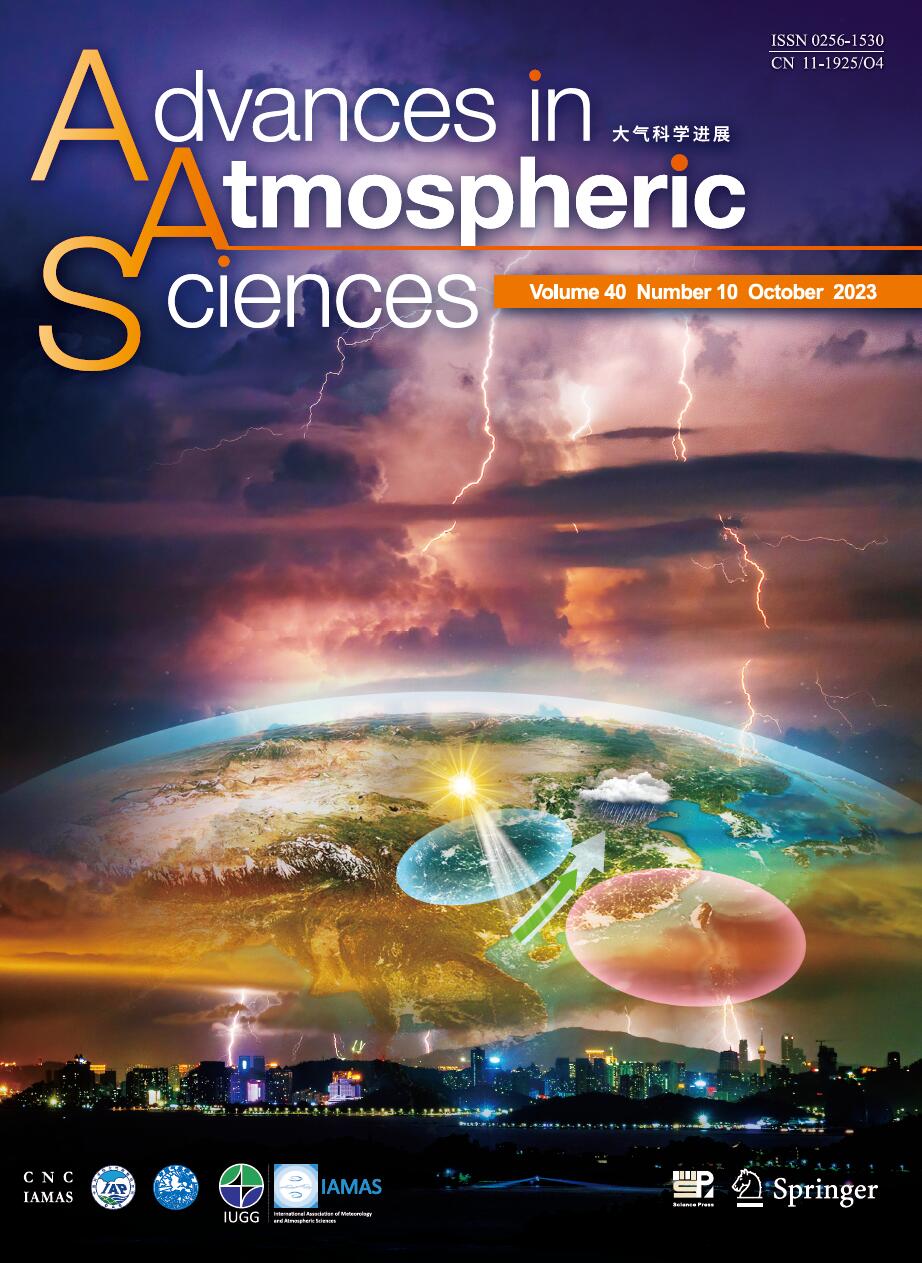| [1] |
Wang Yunfeng, Wu Rongsheng, Wang Yuan, Pan Yinong,
2000: A Simple Method of Calculating the Optimal Step Size in 4DVAR Technique, ADVANCES IN ATMOSPHERIC SCIENCES, 17, 433-444.
doi: 10.1007/s00376-000-0034-5
|
| [2] |
ZHANG Xin, LIU Yuewei, WANG Bin, JI Zhongzhen,
2004: Parallel Computing of a Variational Data Assimilation Model for GPS/MET Observation Using the Ray-Tracing Method, ADVANCES IN ATMOSPHERIC SCIENCES, 21, 220-226.
doi: 10.1007/BF02915708
|
| [3] |
ZHANG Meng, NI Yunqi, ZHANG Fuqing,
2007: Variational Assimilation of GPS Precipitable Water Vapor and Hourly Rainfall Observations for a Meso- Scale Heavy Precipitation Event During the 2002 Mei-Yu Season, ADVANCES IN ATMOSPHERIC SCIENCES, 24, 509-526.
doi: 10.1007/s00376-007-0509-8
|
| [4] |
Shen YAN, Jie XIANG, Huadong DU,
2019: Determining Atmospheric Boundary Layer Height with the Numerical Differentiation Method Using Bending Angle Data from COSMIC, ADVANCES IN ATMOSPHERIC SCIENCES, 36, 303-312.
doi: 10.1007/s00376-018-7308-2
|
| [5] |
KUANG Zheng, WANG Bin, YANG Hualin,
2003: A Rapid Optimization Algorithm for GPS Data Assimilation, ADVANCES IN ATMOSPHERIC SCIENCES, 20, 437-441.
doi: 10.1007/BF02690801
|
| [6] |
Zhu Keyun,
2001: On the 4D Variational Data Assimilation with Constraint Conditions, ADVANCES IN ATMOSPHERIC SCIENCES, 18, 1131-1145.
doi: 10.1007/s00376-001-0028-y
|
| [7] |
WANG Yunfeng, WANG Bin, HAN Yueqi, ZHU Min, HOU Zhiming, ZHOU Yi, LIU Yudi, KOU Zheng,
2004: Variational Data Assimilation Experiments of Mei-Yu Front Rainstorms in China, ADVANCES IN ATMOSPHERIC SCIENCES, 21, 587-596.
doi: 10.1007/BF02915726
|
| [8] |
WANG Bin, LIU Juanjuan, WANG Shudong, CHENG Wei, LIU Juan, LIU Chengsi, Qingnong XIAO, Ying-Hwa KUO,
2010: An Economical Approach to Four-dimensional Variational Data Assimilation, ADVANCES IN ATMOSPHERIC SCIENCES, 27, 715-727.
doi: 10.1007/s00376-009-9122-3
|
| [9] |
Fuqing ZHANG, Meng ZHANG, James A. HANSEN,
2009: Coupling Ensemble Kalman Filter with Four-dimensional Variational Data Assimilation, ADVANCES IN ATMOSPHERIC SCIENCES, 26, 1-8.
doi: 10.1007/s00376-009-0001-8
|
| [10] |
Da-Lin ZHANG, Xiaoxue WANG,
2003: Dependence of Hurricane Intensity and Structures on Vertical Resolution and Time-Step Size, ADVANCES IN ATMOSPHERIC SCIENCES, 20, 711-725.
doi: 10.1007/BF02915397
|
| [11] |
Yaodeng CHEN, Ruizhi ZHANG, Deming MENG, Jinzhong MIN, Lina ZHANG,
2016: Variational Assimilation of Satellite Cloud Water/Ice Path and Microphysics Scheme Sensitivity to the Assimilation of a Rainfall Case, ADVANCES IN ATMOSPHERIC SCIENCES, 33, 1158-1170.
doi: 10.1007/s00376-016-6004-3
|
| [12] |
Chuan GAO, Xinrong WU, Rong-Hua ZHANG,
2016: Testing a Four-Dimensional Variational Data Assimilation Method Using an Improved Intermediate Coupled Model for ENSO Analysis and Prediction, ADVANCES IN ATMOSPHERIC SCIENCES, 33, 875-888.
doi: 10.1007/s00376-016-5249-1
|
| [13] |
Xin LI, Mingjian ZENG, Yuan WANG, Wenlan WANG, Haiying WU, Haixia MEI,
2016: Evaluation of Two Momentum Control Variable Schemes and Their Impact on the Variational Assimilation of Radar Wind Data: Case Study of a Squall Line, ADVANCES IN ATMOSPHERIC SCIENCES, 33, 1143-1157.
doi: 10.1007/s00376-016-5255-3
|
| [14] |
LIU Ye, YAN Changxiang,
2010: Application of a Recursive Filter to a Three-Dimensional Variational Ocean Data Assimilation System, ADVANCES IN ATMOSPHERIC SCIENCES, 27, 293-302.
doi: 10.1007/s00376-009-8112-9
|
| [15] |
Chaoqun MA, Tijian WANG, Zengliang ZANG, Zhijin LI,
2018: Comparisons of Three-Dimensional Variational Data Assimilation and Model Output Statistics in Improving Atmospheric Chemistry Forecasts, ADVANCES IN ATMOSPHERIC SCIENCES, 35, 813-825.
doi: 10.1007/s00376-017-7179-y
|
| [16] |
ZHANG Xiaoyan, WANG Bin, JI Zhongzhen, Qingnong XIAO, ZHANG Xin,
2003: Initialization and Simulation of a Typhoon Using 4-Dimensional Variational Data Assimilation-Research on Typhoon Herb(1996), ADVANCES IN ATMOSPHERIC SCIENCES, 20, 612-622.
doi: 10.1007/BF02915504
|
| [17] |
ZHANG Lin, NI Yunqi,
2005: Four-Dimensional Variational Data Assimilation Experiments for a Heavy Rain Case During the 2002 IOP in China, ADVANCES IN ATMOSPHERIC SCIENCES, 22, 300-312.
doi: 10.1007/BF02918519
|
| [18] |
ZENG Zhihua, DUAN Yihong, LIANG Xudong, MA Leiming, Johnny Chung-leung CHAN,
2005: The Effect of Three-Dimensional Variational Data Assimilation of QuikSCAT Data on the Numerical Simulation of Typhoon Track and Intensity, ADVANCES IN ATMOSPHERIC SCIENCES, 22, 534-544.
doi: 10.1007/BF02918486
|
| [19] |
LIU Juan, WANG Bin, LIU Hailong, YU Yongqiang,
2008: A New Global Four-Dimensional Variational Ocean Data Assimilation System and Its Application, ADVANCES IN ATMOSPHERIC SCIENCES, 25, 680-691.
doi: 10.1007/s00376-008-0680-6
|
| [20] |
LIU Juanjuan, WANG Bin, WANG Shudong,
2010: The Structure of Background-error Covariance in a Four-dimensional Variational Data Assimilation System: Single-point Experiment, ADVANCES IN ATMOSPHERIC SCIENCES, 27, 1303-1310.
doi: 10.1007/s00376-010-9067-6
|















 AAS Website
AAS Website 
 AAS WeChat
AAS WeChat 
 DownLoad:
DownLoad: